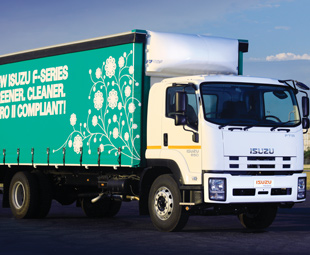Samurai warrior

This month VIC OLIVER puts the new Isuzu FTR 850 fitted with a tautliner body to the test…
To test the handling and performance of the FTR 850, we drove 73 km along highway and secondary roads in the Klipriver area south of Johannesburg and, although the truck was not loaded, I believe I got a fair indication of the new F-Series’ capabilities.
In terms of physical characteristics, with a gross vehicle rating (GVR) of 15 000 kg and an empty tare mass of 7 400 kg – including the tautliner body – this long-wheel-base vehicle offers an excellent legal payload of 7.6 t, making it ideal for short- and medium-distribution haulage. The top of the range F-Series models with a GVR of 24 000 kg are also capable of pulling a trailer.
The cab doors open fully to a 90o angle and good strong steps make the cab entrance and exit easy and safe – important factors when considering how often drivers climb in and out of short- and medium-distance delivery vehicles.
The interior of the cab is spacious, with room for a good deal of luggage. Although not classed as a sleeper cab, the space behind the driver and passenger seats is also sufficient for a driver to rest during a long trip if necessary.
Unfortunately, while air conditioners are not standard, the vehicle has been designed in such a way that one can easily be fitted. A major plus for the driver is how quiet the vehicle is – thanks to the cab’s excellent insulation against noise.
The nuts and bolts
While driving the FTR 850, it quickly became evident that Isuzu has paid a lot of attention to the driveability, performance and safety of the vehicle. Time and again I have witnessed how well a driver cares for a truck that is driver-friendly. It’s a fundamental characteristic upon which “relationships” are built between truck and driver; and a good relationship means a well-maintained truck.
The new Isuzu FTR 850 is most definitely driver-friendly. Its power steering is extremely light to the point where, initially, I was concerned that it might reduce a driver’s ability to “feel” the handling of this vehicle on the road. However, just a few kilometres behind the wheel was all I needed to discover how well I could sense its handling characteristics.
The engine fitted to the truck I was testing produces 176 kW of power and 706 Nm of torque. Coupled to a six-speed transmission, it has the capacity to drive the vehicle in economical mode under all operating and load conditions, including when pulling a trailer. With fuel prices going through the ceiling, consumption is an important consideration for any potential buyer. The test vehicle proved itself a winner in this area, with a fuel consumption of 23.28 l per 100 kilometres although, admittedly, under ideal conditions and unloaded.
The power-to-mass ratio is ideal and, at 80 km/h (the legal speed limit for this vehicle), the engine revs are well within the economical engine range, with plenty of power in reserve to handle hills and steeper gradients.
The 380 mm diameter single-plate clutch fitted to the vehicle is air-assisted and hydraulically operated, again making the vehicle driver-friendly and easy to handle. It is also well-matched to the torque produced by the engine, so clutch life expectancy should be good.
The gear split in the vehicle’s six-speed transmission is well spaced, allowing the driver to select the correct gear at all times without overloading the clutch and drive-train. The deep first gear ratio of 6.615:1 gives the Isuzu FTR 850 a good grade-ability of 34.59%. However, what I did not particularly enjoy while driving the vehicle is the fact that first gear is not a synchromesh gear. As a result, gear change to and from first is not particularly smooth, and there were times when I found engaging second gear difficult. In fairness to the manufacturer, this might have been because the test vehicle had already been driven approximately 4 000 km by multiple drivers during the recent launch of Isuzu’s F-Series, so its gearbox linkages could have been stretched.
Multi-leaf springs fitted to the front and rear axles, with shock absorbers in the front and a stabiliser bar, make the FTR 850 a comfortable drive. The vehicle remained stable under all varying road conditions encountered during the test run.
Fitted with a full anti-lock air brake system (ABS), the stopping ability of the Isuzu FTR 850 is incredible, to say the very least. An added road safety bonus is that automatic brake slack adjusters ensure that the brake lining adjustment against the brake drum is always set correctly, providing optimum braking on each wheel at all times. An effective exhaust brake has also been fitted to facilitate deceleration.
The radial 11R22.5-16 Pr tyres fitted all round improve the FTR 850’s rolling resistance, which in turn reduces fuel consumption. The vehicle’s spare wheel is housed at the rear of the chassis and is easily accessible. The engine oil dipstick, radiator coolant reservoir and power steering reservoir are all situated on the left-hand side of the vehicle, so they are easily visible without having to tilt the cab.
Operators will also enjoy the Isuzu FTR 850’s 20 000 km service interval: another important feature that lowers maintenance costs and improves availability-time.
Overall, an enjoyable truck to drive with good performance and handling capabilities.
Published by
Focus on Transport
focusmagsa



